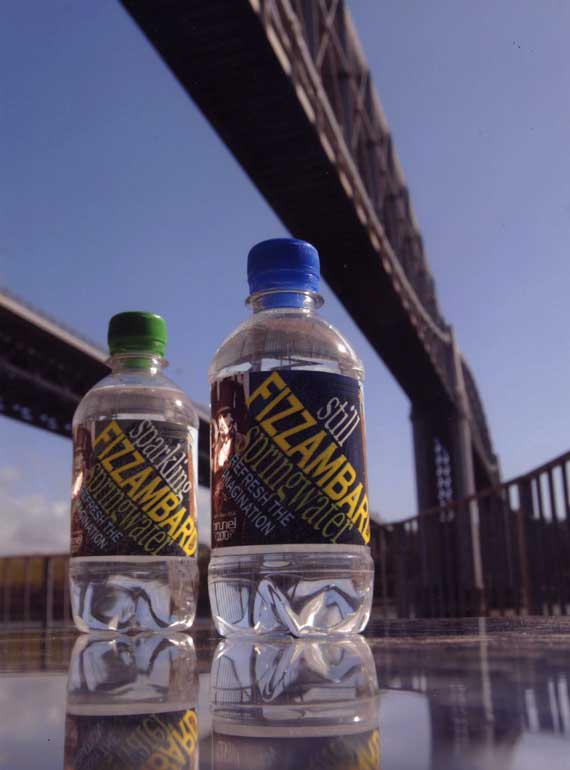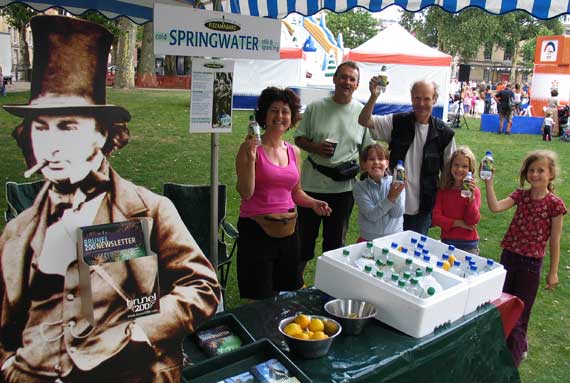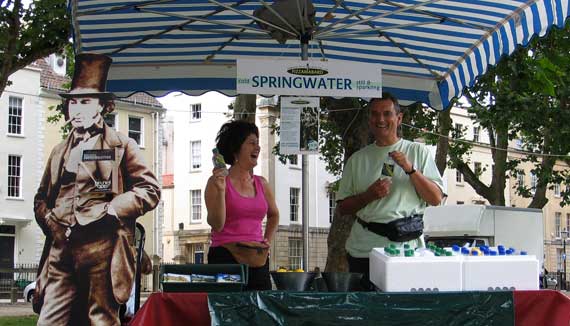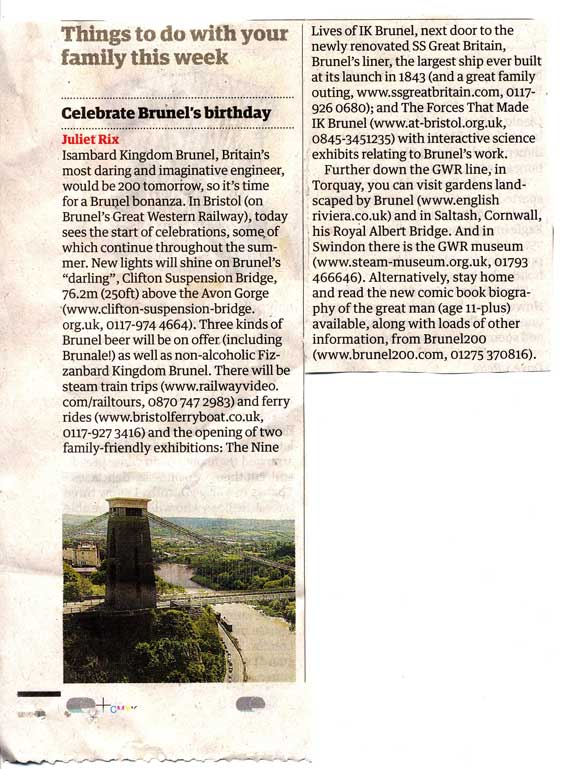|
|



| Fizzambard
Kingdom Brunel: Innovations in Iron and Steel |

C&M Associates created a souvenir/commemorative
drink
bottle for Brunel 200. The visual design brought together images
of Brunel and some of his achievements with the accompanying text inviting
the reader to ‘find out more’.
This is their report on the
development of their original idea and the processes they went through
in bringing their project to fruition:
The original submission
for Fizzambard was to produce a traditional
or good quality sparkling lemonade in a commemorative can.
We liked the idea of creating an apparently ‘branded’ product
with the name Fizzambard (playing on
the name Isambard), to which we’d
added the slogan ‘Refresh the Imagination’ that referred
to the importance of ‘imagination’ as an ingredient of Brunel’s
genius (and a facility that we all share).
There wouldn’t be very much room on the can surface to say very
much about the great man but we thought we could point to some of his
achievements pictorially and signpost people to the very informative
Brunel 200 website. As C&M associates had written and designed a
fair few interpretation boards in the previous 18 months we were used
to telling stories in small spaces and interested in how to supplement
information via websites. In some ways we thought of the project as an
interpretation board wrapped round a can.
We also liked the qualities
of the printed can surfaces, which would allow an attractive design,
creating a semi-permanent commemorative object. But there were other
aspects of a can that we would also be able to draw on. We wanted the
can to be made of steel, which would be in the tradition of working with
ferrous technologies, so ably exploited and extended by Brunel. We also
wanted the consumer to consider that the humble drinks-can also had a
place in the progress and tradition of engineering achievement, and by
inference that Brunel was not an historically static figure, a designer
of Victorian set pieces, but a maker of the modern world.
So we were very
pleased that our project was selected as well as just a bit surprised – we wondered whether the idea might be thought
just a touch frivolous. But it seemed that the selection group had both
enjoyed the joke in the brand-name, but also thought … “What
a good idea!”
The next stage of the project was more sobering but
also illuminating. There hadn’t been time to research the manufacture
or distribution of fizzy drinks in cans before submitting our ideas.
Now we were going to find out a number of awkward truths quite quickly.

| • |
The technology that
puts fizzy drinks in printed cans demands big numbers. The manufacturers
of branded canned drinks, such as 7up or R. White’s Lemonade,
weren’t interested – their brands were sacrosanct.
Manufacturers of canned drinks that might produce an own label
product (as supplied to supermarkets under their names such as
Tesco’s or Sainsbury’s lemonade), were not interested
in runs of less than 250,000, while we were thinking more in terms
of 10,000. |
| |
| • |
Not only does the technology demand
big numbers but so does big business. On some company websites
the first thing they told you was the value of their shares, which
all depended on how many millions units of product they had shifted
that day/week/year. Talking to people in these organisations was
a bit of an uphill struggle. Were we going to make them any money?
Well no. What was our pitch? Local publicity in an important city,
the opportunity to help celebrate a national figure, a weak joke … thanks
but no thanks. |
| |
| • |
We’d airily proposed that
Corus Packaging (heirs to British Steel) might be interested in
being sponsors. Corus Packaging is based in the Netherlands. The
person I spoke to hadn’t even heard of Brunel (although she
agreed to put our proposal to the ‘board’). And, it
transpired, the only soft drinks manufacturer that they supplied
in the UK was Britvic (7up and R. White’s), who weren’t
interested anyway. |
| |
| • |
Many soft drink manufacturers didn’t
use cans, they put their products in bottles. |
| |
| • |
We finally found a company who
would be able to use a shrink-wrap labelling process and they would
be able to apply this technique to blank cans if we could find
somebody to fill some blank cans with lemonade. This didn’t
seem unrealistic but was beginning to depart from our original
model. In the event the only drinks we were able get in blank cans
were so called ‘energy’ drinks, similar to Red Bull,
which were aimed at a young adult ‘clubbing’ group
of consumers … not what we wanted. |
| |
| • |
We’d envisaged a high-quality
lemonade made from spring water and natural or at least traditional
ingredients. We’d followed the few positive leads that our
investigations had offered and found ourselves in a seedy factory
unit in the east end of London. Here we were offered the opportunity
to custom-label an off-tasting lemonade in a bottle. We eyed the
ingredients warily. Amongst other things it contained aspartame,
a sweetener and an ingredient currently enjoying much suspicion
among informed parents. We weren’t going there, it was the
end of the trail. The time had come to think again. |

At the
same time we’d been investigating our potential market
and we’d found that lemonade was problematic in itself. As a rule
pubs and bars won’t sell lemonade in cans or bottles, they prefer
to sell it by the glass filled from a tap at the bar. This mixes carbonated
water with syrup, which delivers a glass of lemonade (or Coke or Pepsi)
at a cost of a few pence. This is sold to the customer at many times
that amount; the profit margin is enormous. Fizzambard, as lemonade canned
or bottled, didn’t fit. Other potential outlets such as museum
shops were uncomfortable with sweet sugary drinks, which could find their
way onto floors and, worse, displays or artefacts.
What we could do was
find suppliers of custom labelled spring water, sparkling or still, in
bottles. Pubs and bars would sell bottled water and people like to know
the provenance of water they are buying (in the customer’s mind,
a tap behind the bar does not add value to water).
We finally found a
supplier who was not only very flexible, delivering what we wanted when
we wanted it at a reasonable price, but also supported a charity – Just
a Drop, delivering water projects in the developing world. How refreshing.
So
Fizzambard became water in a bottle – and as we rolled out
the idea nobody seemed to mind that it wasn’t lemonade in a can.
And as we found out, many people prefer still water to sparkling – so
there also had to be a still Fizzambard, but once again nobody minded
or thought that strange.
The original name was the hook for attention,
providing the opportunity for weak smiles, polite laughter and genuine
amusement. It was a weak joke but one that led to a genuine absurdity.
Exploring the label also leads back to a more serious engagement with
Brunel and his achievements – through
illustration, text and signposting to the website.
I’d like to think
we made a good job of the label, making a cohesive design from disparate
elements; there is actually a huge amount of information packed into
a small space. I had very much wanted to work with metallic colours and
created a very glittery design, as would have been possible on a can
but I think what we got was sufficiently elegant and suited the idea.
It was
also interesting to create a multiple that wasn’t a leaflet
or a book but something which had another function. It handled differently.
Being a bottle of spring water we were able to play with the parallels
between ideas and imagination/springs and spring water. We were able
to exploit the metaphor and say: “Refresh the Imagination” or “Spring
to mind”.

We are enormously grateful to the two outlets who
we approached in the first case – Colin at the Brunel Buttery
and Tom Trevor at the Arnolfini who both said yes almost immediately
and gave us the confidence to go on to offer, persuade and cajole others
to follow suit. With the help of a substantial order from Brunel 200
we quite quickly had orders for several thousand bottles; these included
orders from Saltash and Swindon who were also having Brunel celebrations.
But
as we continued our sales drive it was clear we were approaching a
ceiling. Along with the generous enthusiasm we had one or two surprise ‘no’s’ as
well as reluctance in unexpected quarters. As far as some outlets were
concerned they weren’t going to sell any more bottled water simply
because it was labelled Fizzambard, they made more profit buying from
their usual supplier at prices we clearly couldn’t match. We were
swimming against the commercial current. The second limitation was our
own stamina. How long did we feel we could keep it up? We’d come
to the end of our list of likely outlets and thought our sales were respectable.
This is and has been an interesting project to work
on. It has allowed us to think about other possibilities – about how to distribute
information, and, keeping a weather eye on new technologies, how to link
sources of information together. I feel sure we will be doing other projects
whose structures and ideas will owe a great deal to Fizzambard. But perhaps
the best lesson of all is that jokes are potent things, so if you can, ‘… make ‘em
laugh’, it is definitely the best hook with which to catch people’s
attention.
By curious coincidence while we were researching
the manufacture of fizzy drinks in cans and becoming aware of the scale
of consumption i.e. millions opened and drunk everyday, C&M Associates
were also working on another project to recommend environmental improvements
and interpretation in a public open space in South Bristol.
This site has
a stream flowing through it, which has been dammed to create two small
lakes. Behind each of the weirs and mixed up with other rubbish were
hundreds of floating cans and bottles – a proper eyesore.
Wherever else all the millions of empty cans and bottles go, some of
them end up here and places like it. This is something we really don’t
want to contribute to.
If Fizzambard becomes a local brand it is likely
that it will be served in glass bottles and be sold to be drunk on the
premises in pubs and bars, both factors giving the bottles a better chance
of being recycled.
But at a recent event a young person, who had been
presented with a bottle of Fizzambard, said she wasn’t going to open it but sell
it on ebay – perhaps they are already collectors’ items.
Either
way the message is – careful what you
throw away.
Peter Milner & Ruth Coleman
C&M associates
Links
www.candmassociates.co.uk

|
|